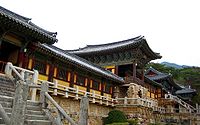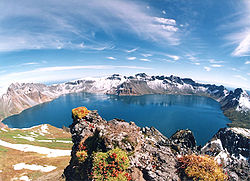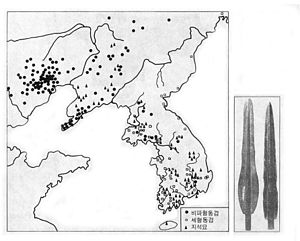- Gojoseon
-
Gojoseon
고조선 (古朝鮮)?–108 BC  →
→
 →
→
 →
→Gojoseon at its decline in 108 BC Capital Wanggeom-seong Language(s) Proto-Korean Religion Korean shamanism Government Monarchy King - 2333 BC - ? Dangun - 1126 BC - 1082 BC Gija - 194 BC - ? Wi Man - ? - 108 BC King Ugeo Historical era Ancient, legendary - legendarily established 2333 BC ? - Fall of Wanggeom-seong 108 BC Gojoseon Hangul 고조선 Hanja 古朝鮮 Revised Romanization Gojoseon McCune–Reischauer Kojosŏn History of Korea 
This article is part of a seriesPrehistory Jeulmun period Mumun period Gojoseon ?–108 BCE Wiman Joseon 194 BCE–108 BCE Proto–Three Kingdoms 300–57 BCE Buyeo, Goguryeo, Okjeo, Dongye Jin state, Samhan (Ma, Byeon, Jin) Four Commanderies of Han Three Kingdoms 57 BCE–668 Goguryeo 37 BCE–668 Baekje 18 BCE–660 Silla 57 BCE–935 Gaya 42–562 North and South States 698–926 Unified Silla 668–935 Balhae 698–926 Later Three Kingdoms 892–936 Taebong, Hubaekje, Silla Goryeo Dynasty 918–1392 Joseon Dynasty 1392–1897 Korean Empire 1897–1910 Colonial Korea 1910–1945 Provisional Gov't 1919–1948 Division of Korea 1945–present North, South Korea 1948–present By topic Timeline List of monarchs Linguistic history Science and technology history Art history Military history Naval history
Korea Portal
History of Manchuria Not based on timeline Early tribes Gojoseon Yan (state) Han Dynasty | Xiongnu Donghu | Wiman Joseon Wuhuan | Sushen | Buyeo | Okjeo Xianbei Cao Wei Jin Dynasty (265–420) Yuwen Former Yan Former Qin Later Yan Goguryeo Balhae (Bohai) Northern Yan Mohe | Shiwei Khitan | Kumo Xi Northern Wei Tang Dynasty Liao Dynasty Jin Dynasty (1115-1234) Yuan Dynasty Ming Dynasty Qing Dynasty Far Eastern Republic Green Ukraine Republic of China Soviet Union Manchukuo China (Northeast China) Russia (Russian Far East) Gojoseon (Korean pronunciation: [kodʑosʌn]) was an ancient Korean kingdom. Go (고, 古), meaning "ancient," distinguishes it from the later Joseon Dynasty; Joseon, as it is called in contemporaneous writings, is also romanized as Chosŏn.
According to the Samguk Yusa and other medieval-era records,[1] Gojoseon is said to have been founded in 2333 BC[2] by Dangun in the legend, who is said to be a Posterity of Heaven.
However, archaeological evidence of Gojoseon is found in the transition from the Jeulmun pottery to the Mumun pottery around 1500 BC, when groups of semi-sedentary small-scale agriculturalists occupied most of the Korean Peninsula. Local bronze production began around the 8th century BC. Based on contemporaneous written records, modern historians generally believe it developed from a loose federation into a powerful kingdom between the 8th and 4th centuries BC.
During its early phase, the capital of Gojoseon was located in Liaoning; around 400 BC, this was moved to Pyongyang, while in the south of the peninsula, the Jin state arose by the 3rd century BC.[3][4]
Gojoseon was invaded by Han Dynasty of China during the Gojoseon–Han War in 108 BC, and followed by successor states and Proto–Three Kingdoms period in Korean history.
The people of Gojoseon are referred to in Chinese records as Dongyi "eastern barbarians." Their language was probably a predecessor of the equally prehistoric Buyeo languages, and perhaps a form of Proto-Korean.[5]
Contents
Founding legend
Main article: Korean founding mythDangun Wanggeom is the legendary founder of Korea. The oldest existing record of this founding myth appears in the Samguk Yusa, a 13th-century collection of legends and stories. A similar account is found in Jewang Ungi. However, no evidence has been found that supports whatever facts may lie beneath this myth.[6]
The Lord of Heaven Hwanin (환인, 桓因, a name which also appears in Indian Buddhist texts), had a son Hwanung (환웅) who yearned to live on the earth among the people. Hwanin relented, and Hwanung descended to Mountain Taebaek with 3,000 helpers, where he founded a city he named Sinsi (신시, 神市, "City of God" or "Holy City"). Along with his ministers of clouds, rain, and wind, he instituted laws and moral codes and taught the people various arts, medicine, and agriculture.
A tiger and a bear living in a cave prayed to Hwanung that they may become human. Upon hearing their prayers, Hwanung gave them 20 cloves of garlic and a bundle of mugwort, instructing them to eat only this sacred food and remain out of the sunlight for 100 days. The tiger shortly gave up and left the cave, but the bear remained and after 21 days was transformed into a woman.
The bear-woman (Ungnyeo, 웅녀, 熊女) was very grateful and made offerings to Hwanung. She lacked a husband, however, and soon became sad and prayed beneath a Sindansu (신단수, 神檀樹, "Divine Betula") tree to be blessed with a child. Hwanung, moved by her prayers, took her for his wife and soon she gave birth to a son, Dangun Wanggeom (단군 왕검, 檀君王儉).
Gojoseon is said to have been established in 2333 BC, based on the description of the Dongguk Tonggam (1485). The date differs among historical sources, although all of them put it during the mythical Yao's reign (traditional dates: 2357 BC – 2256 BC). Samguk Yusa says Dangun ascended to the throne in the 50th year of the legendary Yao's reign, Sejong Sillok says the first year, and Dongguk Tonggam says the 25th year.[7] Some historians suggested that Gojoseon was founded around 3000 BC.[8]
State formation
The earliest written record on Gojoseon has been found in Shang-Shu-Da-Zhuan, recording the founding history of Gija Joseon which is established by Chinese Shang dynasty descendants in 12th century BCE.
Some historians argue that "Dangun" may have been the title of Gojoseon's early leaders. The legitimacy of the Dangun seems to have been derived from the divine lineage of Hwanin, a religious characteristic found in other ancient fortified city-states, such as those of Ancient Greece. The Gyuwon Sahwa (1675) mentions a lineage of 47 Dangun rulers in Gojoseon, ruling from 2333 BC to around 1128 BC. But the authenticity of these books is disputed as the Hwandan Gogi.
By the 4th century BC, other states with defined political structures developed in the areas of the earlier Bronze Age "walled-town states"; Gojoseon was the most advanced of them in the peninsular region.[4] The city-state expanded by incorporating other neighboring city-states by alliance or military conquest. Thus, a vast confederation of political entities between the Taedong and Liao rivers was formed. As Gojoseon evolved, so did the title and function of the leader, who came to be designated as "king" (Han), in the tradition of the Zhou Dynasty, around the same time as the Yan (燕) leader.[9] Records of that time mention the hostility between the feudal state in Northern China and the "confederated" kingdom of Gojoseon, and notably, a plan to attack the Yan beyond the Liao River frontier. The confrontation led to the decline and eventual downfall of Gojoseon, described in Yan records as "arrogant" and "cruel". But the ancient kingdom also appears as a prosperous Bronze Age civilization, with a complex social structure, including a class of horse-riding warriors who contributed to the development of Gojoseon, particularly the northern expansion[10] into most of the Liaodong basin.
Around 300 BC, Gojoseon lost significant western territory after a war with the Yan state, but this indicates Gojoseon was already a large enough state that could wage war against Yan and survive the loss of 2000 li (800 kilometers) of territory.[11] Gojoseon is thought to have relocated its capital to the Pyongyang region around this time.[9]
Gija Joseon
Main article: Gija JoseonAccording to Chinese records, Gija Joseon is the kingdom founded by Shang descendants led by Gija in 12th century BC. The earliest survived Korean record, "History of the Three Kingdoms" admitted Gija Joseon. The Korean historical record "Tongsa Kangmok" (東史綱目) in 1778 AD described Gija's activities and contributions in Gojoseon. The records of Gija refer to laws (Beomgeum Paljo, 범금팔조, 犯禁八條), that are recorded by Book of Han and evidence a hierarchical society and legal protection of private property.[11]
Gija represented the authenticating presence of Chinese civilization, and until the 12th century Koreans commonly believed that Danjun bestowed upon Korea its people and basic culture, while Gija gave Korea its high culture—and presumably, standing as a legitimate civilization.[12] Nationalist sentiment in the modern era has diminished Gija's place today to the point of near extinction.[12] Those Korean scholars deny its existence for various reasons.[13] They point to the book entitled Chu-shu chi-nien (竹書紀年) and Confucian Analects (論語), which were among the first works to mention Gija, but do not mention his migration to Gojoseon.[14] According to the school of historians who believe that Gija Joseon coexisted with Gojoseon of Dangun, Gija Joseon was established at the west end of Gojoseon, which is currently around Hebei, Liaoning and southern east of Inner Mongolia, and was later overthrown by Wiman. Thus Emperor Wu of Han’s conquest of Wiman Joseon was in the western part of Gojoseon, formerly ruled by Gija and his descendants.
Regardless the controversy on Gija, the archaeological discoveries connect the culture of inhabitants with Chinese origins. The crescent-shaped stone knives and grooved stones in the Bronze Age of Korea (around 800BC - 400BC) evidence rice cultivation, which was transmitted to Korea from China, while other artifacts such as Bronze daggers speak the distinctive features of Korea.[15] The artifacts from the Iron Age in Korea such as Chinese coins and Scytho-Siberian style animal-shaped belt buckles present that the iron culture of China and a bronze culture of Scytho-Siberian origin were transmitted into Korea in the 4th century BC.[16]
Wiman Joseon and fall
In 195 BC, King Jun appointed a refugee from Yan, Wiman. Wiman later rebelled in 194 BC, and Jun fled to southern Korean Peninsula.
In 109 BC, Emperor Wu of Han invaded near the Liao River. A conflict would erupt in 109 BC, when Wiman's grandson King Ugeo (右渠, 우거) refused to permit Jin's ambassadors to reach China through his territories. When Emperor Wei sent an ambassador She He (涉何) to Wanggeom to negotiate right of passage with King Ugeo, King Ugeo refused and had a general escort She back to Han territory — but when they got close to Han borders, She assassinated the general and claimed to Emperor Wu that he had defeated Joseon in battle, and Emperor Wu, unaware of his deception, made him the military commander of the Commandery of Liaodong. King Ugeo, offended, made a raid on Liaodong and killed She he.
In response, Emperor Wu commissioned a two-pronged attack, one by land and one by sea, against Joseon. The two forces attacking Joseon were unable to coordinate well with each other and eventually suffered large losses. Eventually the commands were merged, and Wanggeom fell in 108 BC. Han took over the Joseon lands and established Four Commanderies of Han in the western part of former Gojoseon area.
The Gojoseon disintegrated by 1st century BC as it gradually lost the control of its former fiefs. As Gojoseon lost control of its confederacy, many successor states sprang from its former territory, such as Buyeo, Okjeo, Dongye. Goguryeo and Baekje evolved from Buyeo.
Culture
Around 2000 BC, a new pottery culture of painted and chiseled design is found. These people practiced agriculture in a settled communal life, probably organized into familial clans. Rectangular huts and increasingly larger dolmen burial sites are found throughout the peninsula. Bronze daggers and mirrors have been excavated, and there is archaeological evidence of small walled-town states in this period.[10][17] Dolmens and bronze daggers found in the area are uniquely Korean and can't be found in China.
Mumun pottery
In the Mumun Pottery Period (1500–300 BC), plain coarse pottery replaced earlier comb-pattern wares, possibly as a result of the influence of new populations migrating to Korea from Manchuria and Siberia. This type of pottery typically has thicker walls and displays a wider variety of shapes, indicating improvements in kiln technology.[4] This period is sometimes called the "Korean bronze age", but bronze artifacts are relatively rare and regionalized until the 7th century BC.
Rice cultivation
Sometime around 1200 to 900 BC, rice cultivation spread to Korea from China and Manchuria. The people also farmed native grains such as millet and barley, and domesticated livestock.[18]
Bronze tools
Main article: Liaoning bronze dagger cultureThe beginning of the Bronze Age on the peninsula is around 900 BC - 800 BC.[19] Although the Korean Bronze Age culture derives from the Liaoning and Manchuria, it exhibits unique typology and styles, especially in ritual objects.[citation needed]
By the 7th century BC, a Bronze Age material culture, with influences from northeastern China as well as Siberia and Scythian bronze styles, flourishes on the peninsula. Korean bronzes contain a higher percentage of zinc than those of the neighboring bronze cultures. Bronze artifacts, found most frequently in burial sites, consist mainly of swords, spears, daggers, small bells, and mirrors decorated with geometric patterns.[4][20]
Gojoseon's development seems linked to the adoption of bronze technology. Its singularity finds its most notable expression in the idiosyncratic type of bronze swords, or mandolin-shaped daggers (비파형동검, 琵琶形銅劍). The mandolin-shape dagger is found in the regions of Liaoning, Hebei, and Manchuria down to the Korean peninsula. It suggest the existence of Gojoseon dominions, at least in the area shown on the map. Remarkably, the shape of the "mandolin" dagger of Gojoseon differs significantly from the sword artifacts found in China.
Dolmen tombs
Around 900 BC, burial practices become more elaborate, a reflection of increasing social stratification. Goindol, the Dolmen tombs in Korea and Manchuria, formed of upright stones supporting a horizontal slab, are more numerous in Korea than in other parts of East Asia. Other new forms of burial are stone cists (underground burial chambers lined with stone) and earthenware jar coffins. The bronze objects, pottery, and jade ornaments recovered from dolmens and stone cists indicate that such tombs were reserved for the elite class.[4][21]
Around the 6th century BC, burnished red wares, made of a fine iron-rich clay and characterized by a smooth, lustrous surface, appear in dolmen tombs, as well as in domestic bowls and cups.[4]
Iron culture
Around this time, Jin state occupied the southern part of the Korean peninsula. Very little is known about this state, except it was the apparent predecessor to the Samhan confederacies.
Around 300 BC, iron technology was introduced into Korea from Yan state. Iron was produced locally in the southern part of the peninsula by the 2nd century BC. According to Chinese accounts, iron from the lower Nakdong River valley in the southeast, was valued throughout the peninsula and Japan.[4]
Proto–Three Kingdoms
Main article: Proto–Three Kingdoms of KoreaNumerous small states and confederations arose from the remnants of Gojoseon, including Goguryeo, Buyeo, JeonJoseon, Okjeo, and Dongye. Three of the Chinese commanderies fell to local resistance within a few decades, but the last, Nakrang, remained an important commercial and cultural outpost until it was destroyed by the expanding Goguryeo in 313.
King Jun of Gojoseon is said to have fled to the state of Jin in southern Korean peninsula. Jin developed into the Samhan confederacies, the beginnings of Baekje and Silla, continuing to absorb migration from the north. Goguryeo, Baekje, and Silla gradually grew into the Three Kingdoms of Korea that dominated the entire peninsula by around the 4th century.
See also
- Names of Korea
- History of Korea
- List of Korea-related topics
- List of Korean monarchs
- Three Confederate States of Gojoseon
Notes
- ^ See also Jewang Ungi, Dongguk Tonggam, Sejong Sillok, and Chronicle of Korean Rulers, Jewang yeondaeryeok (제왕연대력, 帝王年代曆), written by Choe Chiwon (최치원) (857 – ?)
- ^ http://rki.kbs.co.kr/english/korea/aboutkorea/korea_abouthistory.htm
- ^ "고조선(古朝鮮)". http://enc.daum.net/dic100/viewContents.do?&m=all&articleID=b01g4157b.
- ^ a b c d e f g "Timeline of Art and History, Korea, 1000 BC – 1 AD". Metropolitan Museum of Art. http://www.metmuseum.org/toah/ht/04/eak/ht04eak.htm.
- ^ Jaehoon Lee (2004). "The Relatedness Between The Origin of Japanese and Korean Ethnicity". The Florida State University. pp. 31. http://etd.lib.fsu.edu/theses/available/etd-09022004-124406/unrestricted/13ancientjapaneseandkoreanconnection.pdf. Retrieved 2007-04-11.
- ^ Mary E. Connor, "The Korea, A global studies handbook", 2002, pp. 10
- ^ Yoon, N.-H. (윤내현), The Location and Transfer of Go-Chosun's Capital (고조선의 도읍 위치와 그 이동), 단군학연구, 7, 207–38 (2002)
- ^ 허종호, 고조선력사 개관 (An Introduction to Gojoseon's History), 사회과학원 (2001) ISBN 89-89524-04-0
- ^ a b "Korea's Place in the Sun". The New York Times. http://www.nytimes.com/books/first/c/cumings-korea.html?_r=1&oref=slogin.
- ^ a b Daum 백과사전 : 고조선
- ^ a b Kyung Moon hwang, "A History of Korea, An Episodic Narrative", 2010, pp. 4
- ^ http://www.dbpia.co.kr/view/ar_view.asp?pid=694&isid=30674&arid=657709&topMenu=&topMenu1=
- ^ 네이버 백과사전
- ^ Carter J. Eckert, el., "Korea, Old and New: History", 1990, pp. 10
- ^ Carter J. Eckert, el., "Korea, Old and New: History", 1990, pp. 12
- ^ North Korea - The Origins Of The Korean Nation
- ^ "Timeline of Art and History". Metropolitan Museum of Art. http://www.metmuseum.org/toah/ht/04/eak/ht03eak.htm.
- ^ Carter J. Eckert, el., "Korea, Old and New: History", 1990, pp. 9
- ^ The Metropolitan Museum of Art: Arts of Korea, Bronze Age Objects
- ^ Unesco.
Categories:- Former monarchies
- Former countries in East Asia
- Gojoseon
- Former countries in Korean history
- 108 BC disestablishments
Wikimedia Foundation. 2010.



